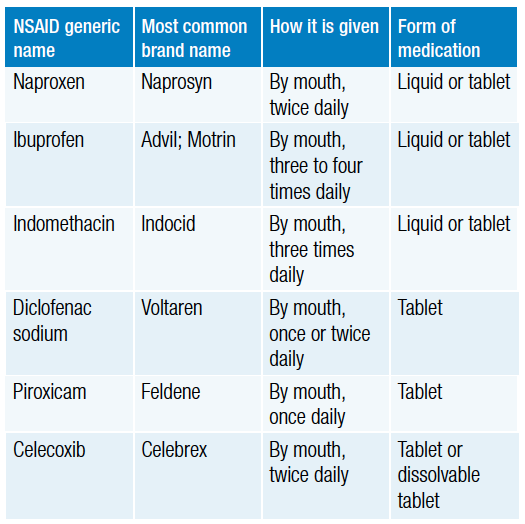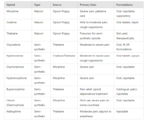Pain medications can be broadly classified into two categories: prescription and nonprescription. In the latter category are several mild anti-inflammatory drugs (ibuprofen, naproxen), as well as acetaminophen. These are mainly meant for use with short-term, acute pain — menstrual cramps, tension headaches, minor sprains — what are known colloquially as “everyday aches and pains.”
Over-the-counter pain relievers, especially acetaminophen, are also sometimes used to treat chronic pain, such as that seen in arthritis. These drugs also lower fever and are often used for that purpose.

The prescription arsenal against pain is extensive. It also includes some NSAIDs more powerful than their over-the-counter cousins as well as opioid analgesics. And then there are some unconventional analgesics – drugs which were not originally developed as pain-relievers, but which were found to have pain-relieving properties in certain conditions.
For example, fibromyalgia pain medications include an anti-seizure drug and an antidepressant.
One major difference between anti-inflammatories and opioid analgesics is that the former have a “ceiling effect” — that is, continuous dose escalation does not provide concomitant escalation in pain relief. One reason opioids are so useful in the treatment of chronic pain is that as tolerance to a dose develops, the dose can be raised. In fact, there is no limit to how high opioid dosing can go -– keeping in mind that higher doses can be associated with unpleasant and/or even dangerous side effects.
Pain relievers are medicines that reduce or relieve headaches, sore muscles, arthritis, or other aches and pains. There are many different pain medicines, and each one has advantages and risks. Some types of pain respond better to certain medicines than others. Each person may also have a slightly different response to a pain reliever. Over-the-counter (OTC) medicines are good for many types of pain. There are two main types of OTC pain medicines: acetaminophen (Tylenol) and nonsteroidal anti-inflammatory drugs (NSAIDs). Aspirin, naproxen (Aleve), and ibuprofen (Advil, Motrin) are examples of OTC NSAIDs.
OTC Medications
These relieve the minor aches and pains associated with conditions such as headaches, fever, colds, flu, arthritis, toothaches, and menstrual cramps.
There are basically two types of OTC pain relievers: acetaminophen and non-steroidal anti-inflammatory drugs (NSAIDs).
Acetaminophen is an active ingredient found in more than 600 OTC and prescription medicines, including pain relievers, cough suppressants, and cold medications.
NSAIDs are common medications used to relieve fever and minor aches and pains. They include aspirin, naproxen, and ibuprofen, as well as many medicines taken for colds, sinus pressure, and allergies. They act by inhibiting an enzyme that helps make a specific chemical.
If OTC medicines don’t relieve your pain, your doctor may prescribe something stronger. Many NSAIDs are also available at higher prescription doses. The most powerful pain relievers are opioids. They are very effective, but they can sometimes have serious side effects. There is also a risk of addiction. Because of the risks, you must use them only under a doctor’s supervision.
The most common medicines are listed below. Each one may have side effects. These can range from mild to severe. It’s important to follow your doctor’s orders on how to use your pain medicine. If you have questions about side effects or about how much medicine to take, ask your doctor or pharmacist.
These relieve the minor aches and pains associated with conditions such as headaches, fever, colds, flu, arthritis, toothaches, and menstrual cramps.
There are basically two types of OTC pain relievers: acetaminophen and non-steroidal anti-inflammatory drugs (NSAIDs).
Acetaminophen is an active ingredient found in more than 600 OTC and prescription medicines, including pain relievers, cough suppressants, and cold medications.
NSAIDs are common medications used to relieve fever and minor aches and pains. They include aspirin, naproxen, and ibuprofen, as well as many medicines taken for colds, sinus pressure, and allergies. They act by inhibiting an enzyme that helps make a specific chemical.
Prescription Medications
Typical prescription pain relief medicines include opioids and non-opioid medications.
Derived from opium, opioid drugs are very powerful products. They act by attaching to a specific “receptor” in the brain, spinal cord, and gastrointestinal tract. Opioids can change the way a person experiences pain.
Types of prescription opioid medications include
- morphine, which is often used before and after surgical procedures to alleviate severe pain
- oxycodone, which is also often prescribed for moderate to severe pain
- codeine, which comes in combination with acetaminophen or other non-opioid pain relief medications and is often prescribed for mild to moderate pain
- hydrocodone, which comes in combination with acetaminophen or other non-opioid pain relief medications and is prescribed for moderate to moderately severe pain
Different Types of Pain Medications
Acetaminophen

Acetaminophen helps many kinds of chronic pain. One brand name is Tylenol. It is also found in many over-the-counter and prescription pain medicines. If you’re not careful, you could take more acetaminophen than is good for you. Too much acetaminophen can cause liver damage, especially if you drink alcohol. Tell your doctor if you have to take more than 2 acetaminophen pills a day.
Nonsteroidal Anti-Inflammatory Drugs (NSAIDs)

Other drugs that help with pain are nonsteroidal anti-inflammatory drugs (NSAIDs). Examples include aspirin, ibuprofen (two brand names: Motrin, Advil), and naproxen (one brand name: Aleve). NSAIDs come in both over-the-counter and prescription forms. These medicines can be taken sometimes or every day. When taken regularly, they build up in the blood to fight inflammation (swelling) and give general pain relief.
Always take NSAIDs with food or milk because the most common side effects are related to the stomach. Other side effects include:
- Increased bruising.
- Risk of bleeding in the stomach.
- Kidney damage (when taken for long periods of time).
- High blood pressure.
- Interference with blood pressure medicines.
If you take other pain medicines, do not take NSAIDs without talking to your doctor first.
Antidepressants
Many drugs that treat other illnesses can also treat chronic pain. For example, antidepressants can improve function and provide pain relief. Antidepressants may be used to treat nerve damage, arthritis, and fibromyalgia. They also may help with headaches, facial pain, low back pain, and pelvic pain. It can take several weeks for the medicines to start working.
Types of antidepressants your doctor may prescribe include:
- Tricyclic antidepressants (TCAs), such as amitriptyline (Elavil), imipramine (Tofranil), nortriptyline (Pamelor), and doxepin.
- Selective serotonin/norepinephrine reuptake inhibitors (SNRIs), such as duloxetine (Cymbalta).
- Selective serotonin reuptake inhibitors (SSRIs), such as fluoxetine (Prozac), paroxetine (Paxil), and sertraline (Zoloft).
Possible side effects of antidepressants include:
- nausea
- drowsiness
- insomnia (trouble sleeping)
- dry mouth
- dizziness
- constipation
- weight gain
- heart problems
TCAs tend to have more side effects than SNRIs or SSRIs, but they usually are mild. Your doctor may start you on a low dose of medicine. This helps prevent side effects and allows your body to adjust. The doctor may increase the amount over time. If at any point while taking medicine you become depressed or have suicidal thoughts, call your doctor right away.
Anticonvulsants
Your doctor may want you to try an anticonvulsant medicine. It may help reduce some types of chronic pain, such as low back pain. Examples of anticonvulsants are:
- gabapentin (Neurontin)
- carbamazepine (Tegretol)
- phenytoin (Dilantin)
- pregabalin (Lyrica)
- topiramate (Topamax)
Like antidepressants, your doctor may start you on a low dose of anticonvulsants. This helps prevent or reduce side effects. The doctor may increase the amount over time. Contact your doctor right away if you have suicidal thoughts. Minor side effects may include:
- drowsiness
- nausea or vomiting
- restlessness
- dizziness
- loss of appetite
- weight gain
- itching or swelling
Narcotics/Opioids
Doctors rarely prescribe narcotics or opioids to treat chronic pain. This is because they are highly addictive. Currently, there is an opioid crisis in the United States. People who become addicted can develop severe symptoms, such as increased pain, depression, or suicidal thoughts. They may begin to abuse other substances, or their behaviors could become harmful or violent. Addicts are at risk of misusing or overdosing on narcotics, which can cause death. Talk to your doctor about all risks of narcotics before starting a new medicine.
If your doctor does prescribe a narcotic, be sure to follow their directions. Do not drive or operate heavy machinery when taking narcotics. Do not use alcohol as well. Tell your doctor if you have side effects from narcotics. These may include nausea, constipation, and trouble focusing or thinking clearly. Your doctor can prescribe an anti-nausea drug or laxative to help with side effects.
When you’re taking narcotics, it’s important to remember the difference between “physical dependence” and “psychological addiction.” Physical dependence means that your body adjusts to a medicine and needs it in order to function. When you function has improved, your doctor will help you slowly and safely decrease the amount of medicine. Doing this helps prevent or reduce symptoms of withdrawal. It is critical to tell your doctor about these symptoms and work through the process together.

The Names of Common Opioids
- Codeine
- Fentanyl — available as a patch
- Hydrocodone
- Hydromorphone
- Meperidine
- Morphine
- Oxycodone
- Tramadol
Taking Opioids
These drugs can be abused and habit-forming. Always take narcotics as prescribed. Your provider may suggest that you take your medicine only when you feel pain.
Or, your provider may suggest taking a narcotic on a regular schedule. Allowing the medicine to wear off before taking more of it can make the pain difficult to control.
Contact your provider right away if you feel you are addicted to the drug. A sign of addiction is a strong craving for the drug that you can’t control.
Taking narcotics to control the pain of cancer or other medical problems does not itself lead to dependence.
Store narcotics safely and securely in your home.
You may need a pain specialist to help you manage long-term pain.
Side Effects of Opioids
Drowsiness and impaired judgment often occur with these medicines. When taking a narcotic, do not drink alcohol, drive, or operate heavy machinery.
You can relieve itching by reducing the dose or talking to your provider about switching medicines.
To help with constipation, drink more fluids, get more exercise, eat foods with extra fiber, and use stool softeners.
If nausea or vomiting occur, try taking the narcotic with food.
Withdrawal symptoms are common when you stop taking a narcotic. Symptoms include strong desire for the medicine (craving), yawning, insomnia, restlessness, mood swings, or diarrhea. To prevent withdrawal symptoms, your provider may recommend you gradually lower the dosage over time.
Mixed opioid agonist-antagonists
Patients can experience symptoms of opioid withdrawal if a straight opioid analgesic, such as morphine, is taken at the same time as an opioid agonist-antagonist drug. Some of these medications include pentazocine (Talwin Nx, Talacen, Talwin Compound), butorphanol, and nalbuphine (Nubain).
Muscle relaxants

The main side effect of muscle relaxants is drowsiness. This may be how they work to “relieve” pain. In addition, carisoprodol (Soma) use may lead to dependence because in the body it is converted into a drug similar to barbiturates; cyclobenzaprine (Flexeril) can cause dry mouth, constipation, confusion, and loss of balance; methocarbamol (Robaxin) discolors the urine to green, brown, or black; both metaxalone (Skelaxin) and chlorzoxazone (Parafon Forte, DSC) should be used with caution in those with liver problems.
Anti-anxiety agents
Anti-anxiety drugs also carry the risk of sedation, particularly if combined with certain other medications (such as opioid analgesics) or alcohol. Other possible side effects include psychological changes, headache, nausea, visual problems, restlessness, and nightmares. Chest pain and heart pounding are also possible.
Antiseizure agents
Side effects associated with the anticonvulsants used for pain management commonly disappear over time. They include dizziness, drowsiness, and swelling of the lower extremities.
Corticosteroids
In general, short-term and/or low-dose corticosteroid use results in few side effects. But taking corticosteroids long-term can result in severe side effects, including:
- Adrenal insufficiency — a condition in which the body cannot adequately respond to physical stress
- Atherosclerosis
- Bone death
- Cataracts and glaucoma
- Elevated blood pressure
- Elevated blood sugar
- Fluid retention
- Gastrointestinal bleeding
- Mood changes
- Osteoporosis
- Suppression of the immune system
- Trouble sleeping
- Weight gain
- Damage to local tissues
What are the Differences among Different Types of Pain Medications?
Pain medications can be broadly classified into two categories: prescription and nonprescription. In the latter category are several mild anti-inflammatory drugs (ibuprofen, naproxen), as well as acetaminophen. These are mainly meant for use with short-term, acute pain — menstrual cramps, tension headaches, minor sprains — what are known colloquially as “everyday aches and pains.” Over-the-counter pain relievers, especially acetaminophen, are also sometimes used to treat chronic pain, such as that seen in arthritis. These drugs also lower fever and are often used for that purpose.
The prescription arsenal against pain is extensive. It also includes some NSAIDs more powerful than their over-the-counter cousins as well as opioid analgesics. And then there are some unconventional analgesics – drugs which were not originally developed as pain-relievers, but which were found to have pain-relieving properties in certain conditions. For example, fibromyalgia pain medications include an antiseizure drug (pregabalin [Lyrica]) and an antidepressant (duloxetine hydrochloride [Cymbalta]).
One major difference between anti-inflammatories and opioid analgesics is that the former have a “ceiling effect” — that is, continuous dose escalation does not provide concomitant escalation in pain relief. One reason opioids are so useful in the treatment of chronic pain is that as tolerance to a dose develops, the dose can be raised. In fact, there is no limit to how high opioid dosing can go -– keeping in mind that higher doses can be associated with unpleasant and/or even dangerous side effects.
Pain Medications, Pain Relief, and Pain Management





